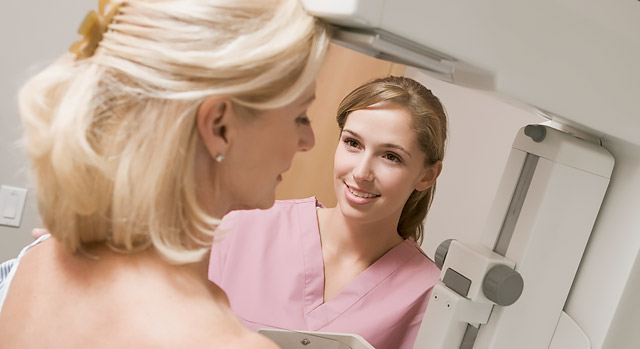You're Never Too Busy for Your Annual Mammogram
The American Cancer Society® recommends that women age 40 and older have a 3D mammogram every year. A 3D mammogram is an X-ray of the breast that uses very low levels of radiation. Because of the low radiation level of the exam, there is no increased risk of breast cancer from the procedure. The American Cancer Society compares the amount of radiation dosage from a 3D mammogram to the amount of radiation exposure from a flight between California and New York City.
Medicare, MediCal and most health plans cover all or part of the cost of this test. Women without health insurance should contact the Every Woman Counts program at 1-800-511-2300. This program provides funding for 3D mammograms and other gynecologic services to women who meet specific income guidelines.
| The Breast Imaging Center is accredited by the American College of Radiology in 3D mammography. |
|---|
3D Mammography
3D mammography, or breast tomosynthesis, is a highly advanced procedure for breast cancer screening that can drastically improve results. The Breast Imaging Center is the only facility in the Corona region that offers 3D mammography.
3D mammography can result in significant breast cancer detection for some women. Specifically, studies have found enhanced detection through 3D mammography in the following groups:
- Women under the age of 50
- Women with dense breasts
- Premenopausal and perimenopausal women
There are several benefits to 3D breast tomosynthesis, including:
- Sharper, clearer images
- Possible increase in detection
- Reduced need for call-back exams
Ultrasonography
Ultrasound exams use high-frequency sound waves, which are transmitted through the area of the body being studied. No radiation exposure occurs. The sound wave echoes are picked up and displayed on a television screen. This exam is noninvasive and painless and is used mainly to determine if a structure or mass is solid or liquid. It is useful in detecting breast cysts in young women with firm, fibrous breasts.
Core Needle Biopsy
Needle biopsies may be performed when an identified lump is difficult to locate or in areas that look suspicious on the X-ray. After the area is numbed by an injection of local anesthesia, a needle is inserted into the breast. Stereotactic core biopsy computerized equipment maps the location of the mass, and this is used as a guide for the needle placement. Ultrasound may also determine needle placement. A hypodermic needle (like the type used to give injections) is inserted, and a specimen is suctioned (aspirated) for biopsy analysis.
Fine Needle Aspiration
This procedure is performed much like the core needle biopsy, but it uses a thinner needle. The procedure may be performed when an identified lump is difficult to locate or is in an area that looks suspicious on the X-ray. After the area is numbed by an injection of local anesthesia, a needle is inserted into the breast. A hypodermic needle (like the type used to give injections) is inserted, and a specimen is suctioned (aspirated) for biopsy analysis.
Bone Density
Osteoporosis is a disease in which bones become fragile, and therefore are more likely to break. While women are four times more likely than men to develop the disease, men may also be at risk of developing osteoporosis. Osteoporosis is often called the "silent disease" because bone loss occurs without symptoms. People may not know that they have osteoporosis until their bones become so weak that a sudden strain, bump or fall causes a hip fracture or other broken bone.
Your doctor may order a bone mineral density (BMD) test for:
- All postmenopausal women under age 65 who have one or more additional risk factors for osteoporosis (in addition to being postmenopausal and female)
- All women age 65 and older regardless of additional risk factors
- Postmenopausal women who present with fractures (to confirm diagnosis and determine disease severity)
- Women who are considering therapy for osteoporosis if BMD testing would facilitate the decision
- Women who have been on hormone replacement therapy (HRT/ERT) for prolonged periods
A BMD test is painless, noninvasive and safe. It measures your bone density and compares the test results to two standards, or norms, known as "age matched" and "young normal." The age-matched reading compares your bone density to what is expected in someone of your age, sex and size. The young normal reading compares your density to the optimal peak bone density of a healthy young adult of the same sex. Results of the test help your physician determine the best course of action for your bone health.


